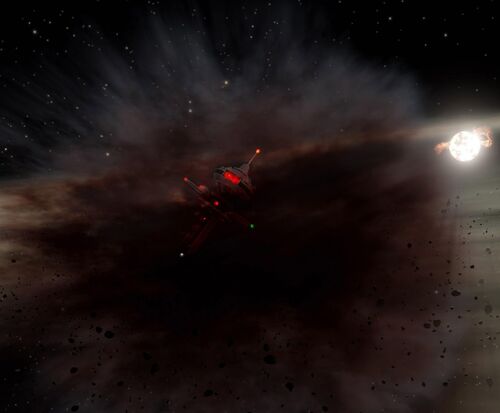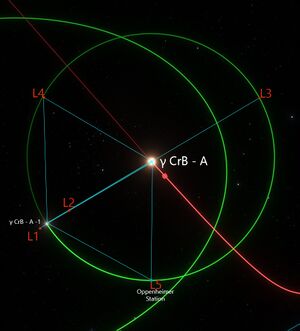Oppenheimer Station
| Oppenheimer Station | |
| Information | |
| Registry | γΑλ5 |
| Class | |
| Affiliation |
None (Formerly United Federation of Planets) |
| Status | Abandoned |
| Commissioned | 2368 |
| Location | |
| System | Gamma Coronae Borealis |
| Sector | Deneb Sector |
| Quadrant | Alpha Quadrant |
| Assignment | |
| Role |
Private Research Outpost |
| Template:Starbase | |
Oppenheimer Station (also known as Oppenheimer Research Outpost) is a Regula Class station located in the Gamma Coronae Borealis system (abbreviated γ CrB).
The facility is fairly unusual in that it is anchored at the trailing L5 Lagrange point with its two parent bodies being the γ CrB - A star and the γ CrB - A1 planet. Over millennia the L5 Lagrange point has accumulated a large amount of stellar debris and dust resulting in the formation of a large Ionised dust cloud that resembles a small micro-nebula
Location
Oppenheimer station is located in the Gamma Coronae Borealis system which is approximately 18 Light years coreward from Farpoint Station.
γ CrB is a binary star system containing a primary star ( γ CrB - A) of spectral classification F7 V and a secondary star ( γ CrB - B) of spectral classification M5 V.
Only γ CrB - A is suitable for Lagrange station keeping due to being the only star in the system to have planets orbiting in Low eccentricity orbits.
Orbital Characteristics
Oppenheimer station occupies the L5 Lagrange point in the orbit of γ CrB - A1. There are usually 5 Lagrange points where the gravitational pull of two massive bodies precatively match the centripetal required for a small object to move with them. In effect this allows a small object (a small station or starship) to remain fixed in space relative to its two parent bodies, with little to no additional energy required for station keeping. The L1. L2 and L3 points are considered "Unstable" and require very precise maneuvering in order to occupy them for any length of time. The L4 and L5 points are much larger and are considered "Stable". They can accumulate matter and debris easily and retain it indefinitely due to the gravitational forces being at equilibrium in these regions; The L5 Lagrange point in particular has accumulated a large amount of stellar debris, forming a dense cloud of Ionised dust. Oppenheimer station is located within this cloud.
L5 Lagrange Cloud Hazards
The cloud of dust that surrounds the station is mostly made up of water ice, micrometeorites, trace gasses, and various pulverized minerals. The matter in the cloud has a very low velocity relative to the station however friction with the station causes a measurable static charge to build up inside the cloud. The electrostatic potential across the cloud can vary greatly to the point that it equalises violently in the form of an electrostatic discharge.
This electrostatic discharge can be a hazard for approaching vessels, especially when approaching and departing the station. Careful attention must be given to the build-up of charge along a ship's hull, relative to that of the surrounding environment and the station itself. The hazard can be mitigated by polarising the hull of a ship to repel the negatively charged matter of the cloud. Deflector shields are largely ineffective at protecting a ship from this phenomenon unless precisely calibrated and in any case this does not prevent a vessel from being struck by an electrostatic discharge.
Another property of the cloud is that due to its density, it serves as an excellent shield for stellar radiation - this is the primary desirable effect of the cloud that lead to the installation of Oppenheimer station in 2369. Its only drawback is that much like stellar nebulae - ship sensors operate with reduced fidelity due to interference. This can be a navigational hazard when approaching the station and most ships have to rely on navigational buoys to guide them safely in to dock.
Finally due to the nature of Lagrange points, larger asteroids and debris can sometimes be captured by the region and either orbit around or enter the cloud completely, while these objects pose little issue when outside the cloud's perimeter, they can be an extreme navigational hazard should they enter the cloud and become concealed. Oppenheimer station is responsible for tracking most objects in the vicinity of the station and if one becomes a hazard, it is usually detected and tugs dispatched to tow it away from any trajectory that would jeopardise the station or shipping lanes
History
Charting of the Gamma Coronae Borealis system (2366)
As Starfleet expanded the Federation's reach beyond Farpoint station and towards the galaxy core, there was a flood of explorers following in the footsteps of the USS Enterprise-D to follow up on its discoveries and establish new colonies and outposts in the wake of this new frontier of exploration. There was a thirst for new science and new beginnings in the region as mankind was still primarily committed to exploring the final frontier rather than defending it.
The Gamma Coronae Borealis system was first charted in 2366 and was found to be largely unremarkable by the first expedition sent to explore. A binary system with only two planets - both gas giants, did not raise much excitement amongst the scientific community for some time. The data on the system was simply cataloged and transmitted back to Starfleet without further scrutiny.
Strategic interest (2367)
During the early/mid-2300's Starfleet was still expending significant resources on scientific research projects into new propulsion and weapons technologies. Many of these projects were classified and were either too hazardous to be carried out close to populated sectors or they were black projects requiring the highest level of secrecy. Starfleet did not want a repeat of the accident in the Lantaru Sector anywhere near federation space, so the decision was made to look towards suitable systems in the outermost regions of known space to conduct this research
In 2367 Gamma Coronae Borealis was selected as one of these systems, both for its location on the edge of federation space and by this point scientists had discovered that the system's possessed an unusually thick cloud of stellar debris which occupied the L5 Lagrange Point of the Primary star. This was a phenomenon of strategic interest for hosting a classified research outpost, both for its radiation-absorbing properties and general concealment from sensor sweeps performed by passing ships.
By the end of 2367, Starfleet granted an operational order to establish an outpost in the system.
Development and Construction (2368-2369)
Throughout the first quarter of 2368, Starfleet sent research vessels to the region to develop the infrastructure for constructing a permanent facility in the system. At first, Starfleet engineers had to design workarounds and procedures for dealing with the navigational hazards and properties of the L5 cloud.
By June 2368 construction was well underway and the station went fully operational in March 2369 - Designated 'Research outpost Lambda 5' after the L5 Lagrange point.
Lambda 5 Research (2369 - 2374)
All research conducted at the Lambda 5 outpost was strictly classified and to the present day the records of the project remain tightly sealed. Research continued for the better part of a decade until the outbreak of the Dominion War in 2373 began to shift Starfleet's focus away from its clandestine research projects and more towards fighting a costly war. Research continued for a short time after the outbreak of war but by 2374 Starfleet was stretched thin and the station's proximity to the borders of the Breen Confederacy meant that the station was under threat of being discovered and captured.
The station was hastily abandoned and intended to be scuttled however in their haste to depart the researchers neglected to activate the auto-destruct sequence, this was a fact that was not discovered until several years later when some of the lead scientists returned after the end of the war with the hopes of rekindling interest for their work.
Oppenheimer Research outpost (2381 - Present)
After discovering the station was still intact, Starfleet considered the possibility of reconstituting the Lambda 5 project and continuing the research conducted there. However, the lessons learned from the dominion war echoed through the federation and the new focus of the administration was towards other galactic-wide issues that required its immediate attention such as open hostilities with the Pakled's, and the brewing crisis In the Romulan Star Empire.
Starfleet chose to abandon the Lambda 5 project for good but transferred the Research outpost to Independent Civilian control. The station's location was de-classified and Starfleet Intelligence ensured that the station's computers were wiped clean and all traces of its past were erased from the record.
By late 2381 the station was occupied once again, This time by private researchers who rechristened the station 'Oppenheimer' after the Infamous J. Robert Oppenheimer of the Manhattan Project. The rechristening of the station gave rise to rumor and speculation about the private research being conducted there, however, the renaming of the station was just something of a joke about the alleged ties to the clandestine research conducted there in the past. Nonetheless, the name remains ominous and wild speculation continues as to the nature of the research presently conducted there.
Deneb Sector Crisis (February - March 2401)
In February 2401, the previously 'lost' Dominion fleet that disappeared in the Bajoran wormhole in 2373; reappeared without warning in the Deneb sector and began a blitzkrieg of the star systems and outposts in the sector.
Oppenheimer station was no exception and soon after the advent of the conflict, a Jem'Hadar strike group attempted to capture the station.
It was later discovered that Oppenheimer station was conducting research into the Penrose process of generating large amounts of energy from a rotating black hole. An experiment, later known as the 'Sutherland Device' was constructed prior to the Invasion to generate a quantum singularity for study.
When the USS Thyanis was dispatched to investigate why the station had not responded to the evacuation order in March 2401, they discovered that the Jem'Hadar had been killed when the Sutherland Device was intentionally de-stabilised, causing the effects of relativity and time dilation to leech out.
The device was later stolen by a Ferengi renegade who delivered it to the Jem'Hadar in person.
As of present day, the station remains abandoned, though the nature of its most recent research seems to have destabilised its capture of the Lagrange point. The station is likely to fall out of the Lagrange point some time in 2402 though at this time it is not possible to estimate its possible future orbit or whether that will be stable.
The debate is still ongoing about what to do with the decaying outpost, with some in favour of intentionally de-orbiting the station into its parent star.


